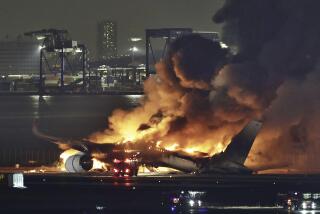Cooler Fuel Tanks Seen Easing Jet Crash Threat
BALTIMORE — Since officials may never determine exactly what touched off the jet fuel blast that downed TWA Flight 800, the best way to prevent similar accidents in the future may be to lower the temperatures in airliner fuel tanks, experts said Tuesday.
Joseph Shepherd, a Caltech engineer, told an afternoon session of the weeklong National Transportation Safety Board hearings on last year’s disastrous crash that the warmer the fuel is, the more easily it can be detonated.
“Tests show that increasing the temperature of jet fuel vapor from 86 degrees Fahrenheit to 140 degrees increases the risk of ignition by a spark by [a factor of] 100,000,” Shepherd said.
Officials said that means it would have taken only a very small spark to set off the center fuel tank explosion that tore the Boeing 747 apart off the coast of Long Island, N.Y., on July 17, 1996, killing all 230 aboard.
Shepherd said the fuel temperature tests produced “one of the most important results” in the 16-month investigation of the crash. He said there would be “a significant gain in safety if the temperature of fuel could be reduced.”
Thomas A. McSweeney, the Federal Aviation Administration’s director of aircraft certification, said Tuesday night that the test results would make his agency “go back and rethink” its decision last week to reject earlier NTSB recommendations to reduce explosion hazards by putting colder fuel in the tanks just before takeoff.
As Flight 800 sat on the ground for more than three hours before takeoff from John F. Kennedy International Airport, air-conditioning systems on the big plane were kept running.
Tests show that these hot-running systems--which are housed under the fuel tank--probably had heated the fuel vapor in the nearly empty center tank to between 123 degrees and 145 degrees by the time the jet took off.
These temperatures apparently cooled to between 113 and 127 degrees as the jetliner climbed through 12,000 feet, but that was still well above the minimum “flash point” temperature at which the fuel would support combustion.
Something--no one is sure what--ignited fumes in Flight 800’s center fuel tank as the plane flew over the Atlantic Ocean at an altitude of 12,800 feet. NTSB investigators, who have ruled out earlier suggestions that a bomb or a missile may have set off the explosion, agree now that static electricity or a spark from worn out or malfunctioning equipment probably triggered the blast.
However, Jerry Hulm, a Boeing Co. engineer, testified Tuesday that after more than a year of exhaustive examination of 747 wiring, pumps, sensors and other electrical paraphernalia, “we have not come across anything that would represent an ignition source in any of our fuel tanks.”
Ivor Thomas, another Boeing engineer, insisted that most of the electrical systems in and around the tanks are so well contained that they are “explosion-proof.” That prompted one observer to remark sarcastically that the blast must have been the result of “immaculate ignition.”
NTSB sources say privately there is a strong possibility the ignition source will never be determined. The force of the blast shattered much of the evidence, and a small spark leaves no telltale signature.
Test blasts of a one-quarter-scale model of the fuel tank could not find an ignition point that might have indicated what went wrong.
More to Read
Inside the business of entertainment
The Wide Shot brings you news, analysis and insights on everything from streaming wars to production — and what it all means for the future.
You may occasionally receive promotional content from the Los Angeles Times.









